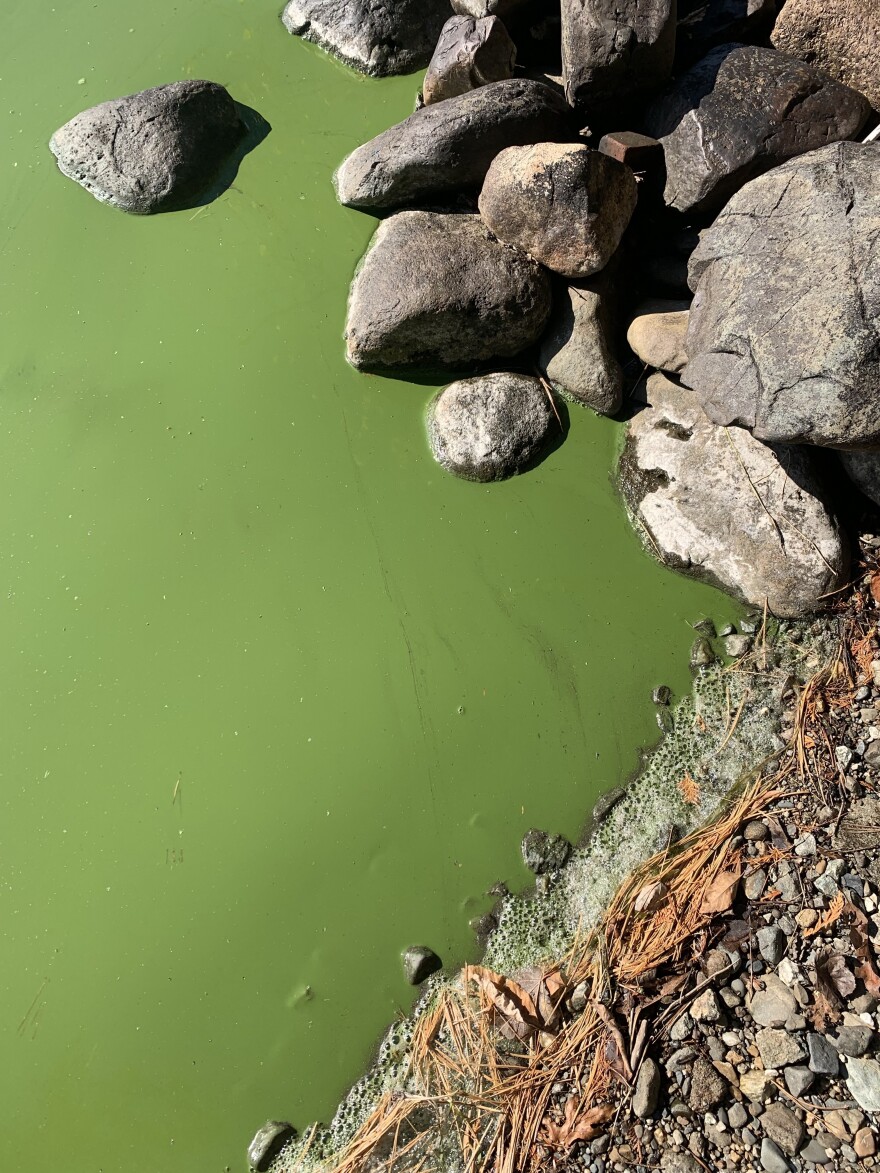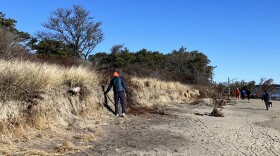Vermont’s Agency of Natural Resource has signed off on a plan to use an aluminum compound to stifle cyanobacteria blooms on Lake Carmi, starting this fall.
It’s the latest in a decade-plus long effort to control toxic blue-green algae blooms on the Franklin County lake, which was declared Vermont’s only lake in crisis in 2018.
Lake Carmi is a popular destination for boating and swimming. It’s also home to a state park with more than 170 campsites and more than 300 lakefront properties. However, locals say it is frequently closed to recreation from late summer into autumn.
“I’ve owned our camp for 20 years, and there hasn’t been a summer where from late July, early August, this lake didn’t have a full in-lake algae bloom, where people couldn’t get into the lake,” says Rob Evans, who leads the Lake Carmi Campers Association and Franklin Watershed Committee. “The smell was awful. You know, fish were dying. And in my opinion, the lake was dying.”
More from Vermont Public: Vermont beaches are closing for cyanobacteria. Here's how to keep track
Evans and other local organizers hope the newly-approved alum treatment can help, by binding with phosphorus near the lake’s bottom and trapping it there, where it won’t cause algae blooms. And while Lake Carmi won’t be the first Vermont water body where the chemical treatment is used, it’s an approach state regulators have so far used sparingly.

The Franklin Watershed Committee has worked for more than two decades to cut the amount of phosphorus that runs into Lake Carmi, in partnership with the state — which faces a mandate from the Environmental Protection Agency to improve water quality there.
After many years of work to reduce runoff from nearby farms, streams and lakefront properties, analysis commissioned by the town of Franklin and Vermont Department of Environmental Conservation suggests that legacy phosphorus in the sediment on the lake’s floor is the leading culprit behind the blooms.
According to the permit, phosphorus that’s built up in the lake over years of runoff prior to regulation accounts for 71% of Lake Carmi’s total phosphorus load.
Cyanobacteria need nutrients like phosphorus and sunlight to thrive. When water from deep in the lake rises over the course of the summer, it carries nutrients like phosphorus — leading to algae blooms.
The state installed an aeration system in Lake Carmi in 2019, in an effort to mix more oxygen into the water near the lakebed and create chemical conditions that would trap phosphorus there, preventing it from rising to the surface.
But scientists with the Department of Environmental Conservation say the system appeared to lead to algae blooms starting earlier in the summer. They stopped operating it in 2024, and removed the infrastructure earlier this year.
“Essentially the aeration system wasn’t able to fully mix the water all the time,” said Peter Isles, who led the project with the Vermont Department of Environmental Conservation. “So if you get a heat wave, the aeration system had to fight against a lot of sunlight and heat — it just wasn’t strong enough to overcome that.”
Alum to trap phosphorus
The Agency of Natural Resources approved the town of Franklin’s bid for a permit to apply the cocktail of naturally occurring chemicals last week.
The permit authorizes the town to use boats to drop a mixture of aluminum sulfate and sodium aluminate over several weeks between Sept. 15 and Nov. 30.
The hope is that the alum compounds will bind with the phosphorus, trapping it in the lake’s depths.
We're going to be covered on this, which is wonderful, because it will end up not costing the taxpayers of town anything.David Bennion, Franklin Select Board Chair
Alum wasn’t the only next step Franklin considered. The town also explored dredging the lake bed and treating the lake with hydrogen peroxide — dredging was estimated to be too expensive and disruptive to recreation, and the lake is too big for a hydrogen peroxide treatment to be effective.
However, at 33 feet deep, Lake Carmi’s shallow nature makes it perfect for an alum treatment, says Isles with the Department of Environmental Conservation.
The permit requires several rounds of monitoring for any adverse impacts to lake life, as well as tests for the concentration of the chemicals in the water column, pH, lake cloudiness, and alkalinity.
More from Vermont Public: Eagle cam at Lake Carmi chronicles a busy nest, 6 years running
Franklin is looking to hire an engineering firm to apply the alum, and the project is expected to cost $3.5 million.
It’s expected to be paid for in full by the state’s Clean Water Revolving Fund and Clean Water Revolving Loan Fund.
“We're going to be covered on this, which is wonderful, because it will end up not costing the taxpayers of town anything,” said Select Board Chair David Bennion.
Local concern — and hope
Bennion says a lot of people in Franklin were initially skeptical about using a chemical to suppress cyanobacteria blooms — himself included.
“Initially, I experienced a fair amount of hesitation about the alum,” he said. “It's, you know, [people] don't like the idea of putting something into the lake that's not naturally there. But we've had numerous meetings, public gatherings about this.”
He says now, most of his constituents are feeling hopeful this might be the thing that works.
Positive testimony at a select board meeting earlier this year from town staff in Fairlee helped put them at ease.
Lake Morey in Fairlee is one of just two other lakes across the state that have received alum treatments (the other is Ticklenaked Pond). The Upper Valley lake was first treated more than 15 years ago, and received a second treatment last year after blooms started to get disruptive again.
Fairlee Town Administrator Ryan Lockwood said the improvement has been striking and immediate.
“So far, the treatment has worked perfectly,” Lockwood said. “We have not seen any evidence of cyanobacteria anywhere this summer or after the treatment.”
This gives us a little bit of breathing room, where folks can see what a lake really should be.Rob Evans, Lake Carmi Campers Association and Franklin Watershed Committee
Lockwood says the town has noticed a boom in the invasive aquatic weed Eurasian milfoil this summer, which state scientists confirmed could be happening because the alum has improved water clarity. He says Fairlee had to move up a semi-annual herbicide treatment to deal with that.
Excessive plant growth is something that concerns Dave Bennion, with the Franklin Select Board.
Vermont has some of the strictest limits on alum in the country. And while it hasn’t been used widely in Vermont to control blooms, it’s been used widely across the United States.
Lake Carmi residents should expect that the water will be clearer after the alum, which will lead to sunlight penetrating deeper into the lake and could result in more aquatic plant growth, said Isles, of the Department of Environmental Conservation.
So long as those plants are native, he said the state views this as a reasonable tradeoff to reduce algae blooms.
According to state records, Lake Carmi does have some Eurasian milfoil in scattered locations along the shoreline.
And while very few impacts to aquatic organisms have been documented after alum treatments elsewhere, Isles says monitoring for aquatic pH levels in the aftermath will be critical to make sure the chemicals don’t harm plants and animals in the lake.

Because of these risks, Isles says the state would be hard-pressed to recommend this solution on other Vermont lakes. He says regulators would rather focus their resources on preventative measures to keep phosphorus out of Vermont waters.
“This is not something that I would expect to be adopted much more widely,” he said.
Still, Evans with the Lake Carmi Campers Association said he’s feeling more hopeful about the alum treatment than he’s felt in years.
“This gives us a little bit of breathing room, where folks can see what a lake really should be,” Evans said. “And hopefully that energizes them even more to get out there and do more work.”
But he said, ultimately, the hard work ahead will be continuing to try to reduce the amount of phosphorus that runs off the land above and around Lake Carmi.





